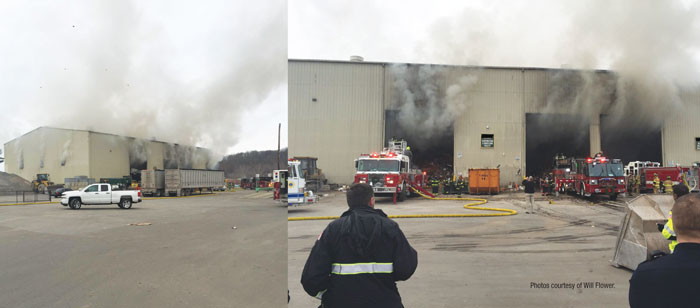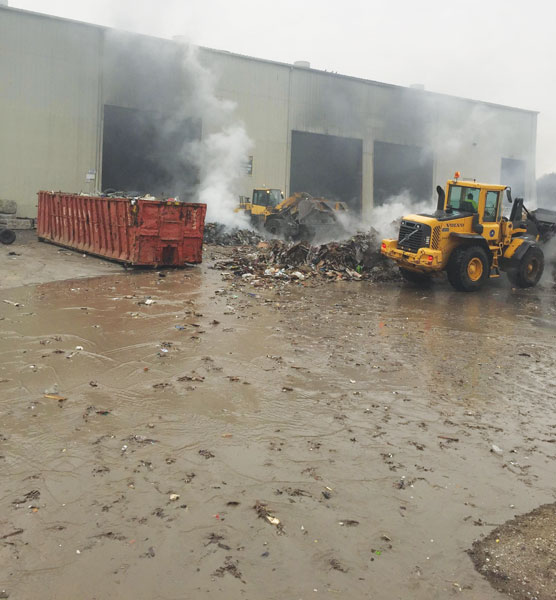Fires in collection trucks, transfer stations, recycling centers and disposal sites are occurring with greater frequency, threatening the safety of workers and emergency responders while costing the industry millions of dollars in damage and higher insurance costs.
By Will Flower
In July 2021, the U.S. EPA issued a report on thegrowing number of fires caused by lithium-ion batteries in the waste management process. The study confirmed what solid waste professionals already knew … lithium battery fires are occurring at a greater frequency across all the entire waste management process, including collection, transfer, recycling and disposal operations resulting in the need for fire prevention. When fires occur, most are extinguished with minimal damage and no disruption in service. However, larger fires can be destructive, resulting in millions of dollars in damages and disruption of critical services.
Because of the danger associated with fires, managers and supervisors must take precautions to prevent them and train employees to respond quickly when a fire occurs. Fires at recycling centers and transfer stations are especially challenging due to the massive amounts of material that can fuel the fire. Once ignited, piles and bales of cardboard, newspaper and plastics can burn for days. Burning piles of solid waste inside a transfer station can be extremely difficult to extinguish.

Right: A recent report by the EPA concluded that lithium battery fires are occurring at a greater frequency across all the entire waste management process, including collection, transfer, recycling and disposal operations.
Fire Prevention
Fire prevention efforts should begin with an overall site assessment to review and eliminate risks that can cause a fire. Housekeeping procedures should be reviewed especially as they relate to the storage of flammable materials and flammable waste (including oily rags). Electrical motors, wiring and rolling stock should also be carefully checked for potential fire hazards. Threats such as tanks of propane, acetylene, oxygen, bales of paper, cardboard or plastics should also be reviewed and addressed. During a facility assessment, review adjacent properties to determine if there are any significant risks from neighboring operations, transportation networks or manufacturing facilities.
Smoke and fire detection systems and fire suppression prevention systems should be inspected to make sure they are functioning properly. Sprinkler systems should be evaluated to ensure they are capable of controlling the spread of large-scale fires.
Pre-Planning
Local fire departments should be familiar with the buildings in their fire protection districts. Pre-planning involves working with the local fire department to help first responders in the event that a fire breaks out and firefighters are called to the facility. To schedule a “walk through”, contact the chief of the local fire department. During the walk through, firefighters and fire officers will identify and become familiar with the site layout including entrances and exits, sources of water, location of utility rooms and specific hazards, such as fueling stations and storage areas for welding tanks and flammable liquids.
Special care must be taken whenever workers are engaged in any operation that generates sparks or uses an open flame, including cutting metal, grinding and welding. Workers should maintain a fire watch to make sure nothing catches fire.

Every facility and every piece of equipment must have an adequate number of fire extinguishers. The National Fire Protection Association recommends that fire extinguishers be placed in warehouses and transfer stations so that no employee needs to travel more than 50 feet in any direction to reach a fire extinguisher (no more than 75 feet is the recommended travel distance for office space). The location of fire extinguishers should be clearly marked and workers should be trained on the general principles of fire extinguisher use. Hands-on training of fire extinguishers should be part of your annual safety training program. New employees should receive emergency training as part of their employee orientation program.
In the event of a fire, all employees should be aware that during a fire, conditions can rapidly deteriorate. Most importantly, every employee needs to know how to evacuate a burning building and where to assemble to make sure all workers are present and accounted for during a fire or other emergency. Fire exits must be kept clear and emergency doors cannot be blocked or locked. A flagpole is a good place to assemble provided it is out of harm’s way and will not interfere with fire trucks and fire engines that are arriving at the scene. Once outside, workers should not return to the building until the “all clear” signal is given.
Consumer Education and Legislation
The number of fires at solid waste facilities is going to increase in future years as lithium batteries are used in a wide array of applications and their presence in the waste stream is growing. Consumer education concerning the risk of fires associated with the improper disposal of lithium–ion batteries must be expanded. Battery manufacturers, municipalities, and solid waste and recycling organizations need to work together to address the growing risk of fires.
Legislation regulating battery disposal and extended producer responsibilities for lithium-ion batteries may be necessary to prevent illegal disposal and the risk of serious fires. In the meantime, managers of solid waste facilities, drivers and equipment operators should always be prepared and take quick action to extinguish a fire and evacuate as needed to make sure workers and the public are safe. | WA
Will Flower is the Senior Vice President of Corporate and Public Affairs at Winters Bros. Waste Systems (Long Island, NY). Will has 38 years of experience in the area of solid waste management and environmental protection. He has worked in the Director’s Office of the Illinois Environmental Protection Agency and held operational and executive leadership positions at Waste Management, Inc., and Republic Services. Inc. Prior to his current position, he served as the president of a large recycling center on Long Island.
Share your safety tip. Submit your suggestions to Will Flower at [email protected].
